2015 FORD SUPER DUTY light
[x] Cancel search: lightPage 29 of 84
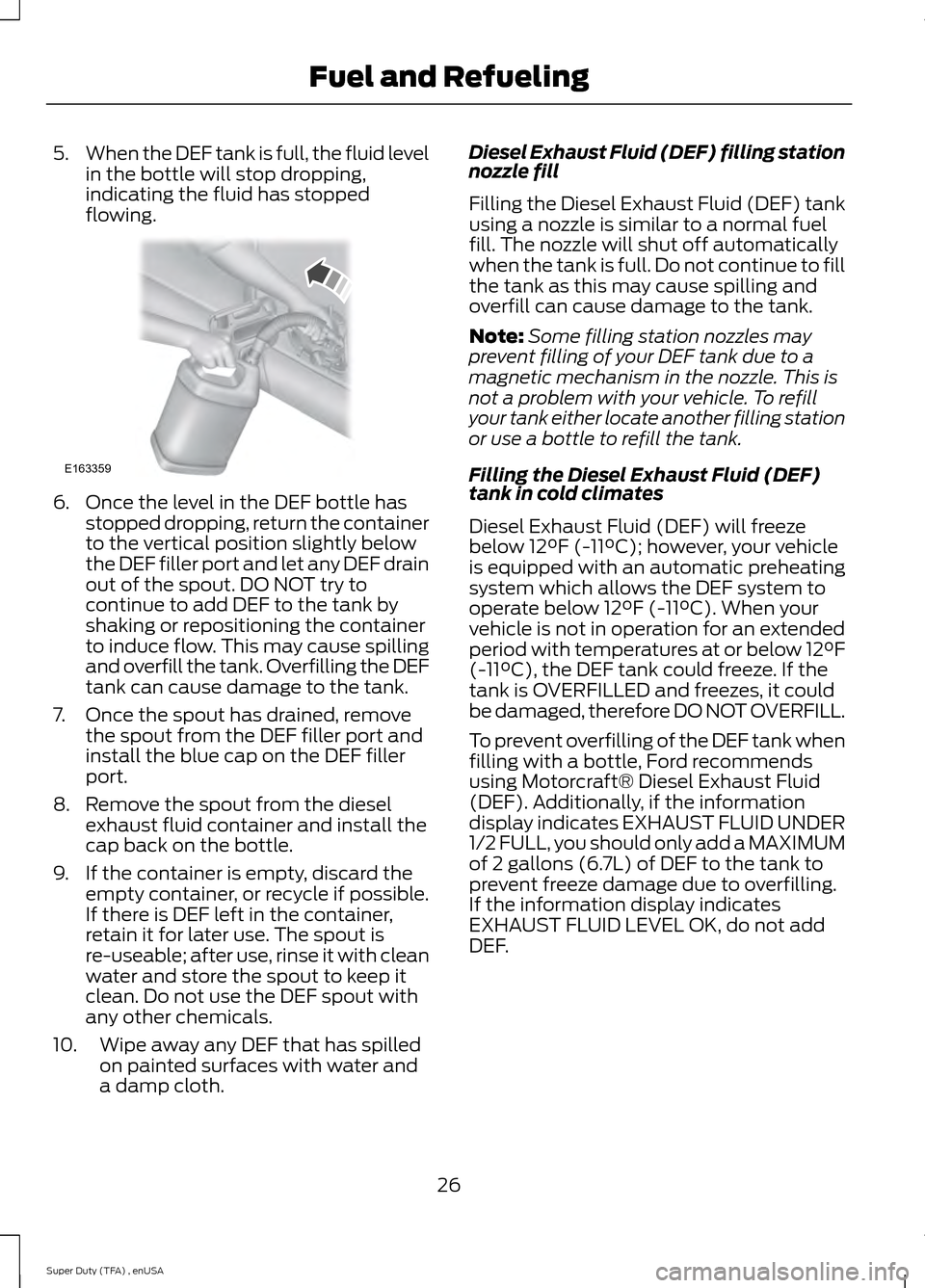
5.
When the DEF tank is full, the fluid level
in the bottle will stop dropping,
indicating the fluid has stopped
flowing. 6. Once the level in the DEF bottle has
stopped dropping, return the container
to the vertical position slightly below
the DEF filler port and let any DEF drain
out of the spout. DO NOT try to
continue to add DEF to the tank by
shaking or repositioning the container
to induce flow. This may cause spilling
and overfill the tank. Overfilling the DEF
tank can cause damage to the tank.
7. Once the spout has drained, remove the spout from the DEF filler port and
install the blue cap on the DEF filler
port.
8. Remove the spout from the diesel exhaust fluid container and install the
cap back on the bottle.
9. If the container is empty, discard the empty container, or recycle if possible.
If there is DEF left in the container,
retain it for later use. The spout is
re-useable; after use, rinse it with clean
water and store the spout to keep it
clean. Do not use the DEF spout with
any other chemicals.
10. Wipe away any DEF that has spilled on painted surfaces with water and
a damp cloth. Diesel Exhaust Fluid (DEF) filling station
nozzle fill
Filling the Diesel Exhaust Fluid (DEF) tank
using a nozzle is similar to a normal fuel
fill. The nozzle will shut off automatically
when the tank is full. Do not continue to fill
the tank as this may cause spilling and
overfill can cause damage to the tank.
Note:
Some filling station nozzles may
prevent filling of your DEF tank due to a
magnetic mechanism in the nozzle. This is
not a problem with your vehicle. To refill
your tank either locate another filling station
or use a bottle to refill the tank.
Filling the Diesel Exhaust Fluid (DEF)
tank in cold climates
Diesel Exhaust Fluid (DEF) will freeze
below 12°F (-11°C); however, your vehicle
is equipped with an automatic preheating
system which allows the DEF system to
operate below 12°F (-11°C). When your
vehicle is not in operation for an extended
period with temperatures at or below 12°F
(-11°C), the DEF tank could freeze. If the
tank is OVERFILLED and freezes, it could
be damaged, therefore DO NOT OVERFILL.
To prevent overfilling of the DEF tank when
filling with a bottle, Ford recommends
using Motorcraft® Diesel Exhaust Fluid
(DEF). Additionally, if the information
display indicates EXHAUST FLUID UNDER
1/2 FULL, you should only add a MAXIMUM
of 2 gallons (6.7L) of DEF to the tank to
prevent freeze damage due to overfilling.
If the information display indicates
EXHAUST FLUID LEVEL OK, do not add
DEF.
26
Super Duty (TFA) , enUSA Fuel and RefuelingE163359
Page 30 of 84
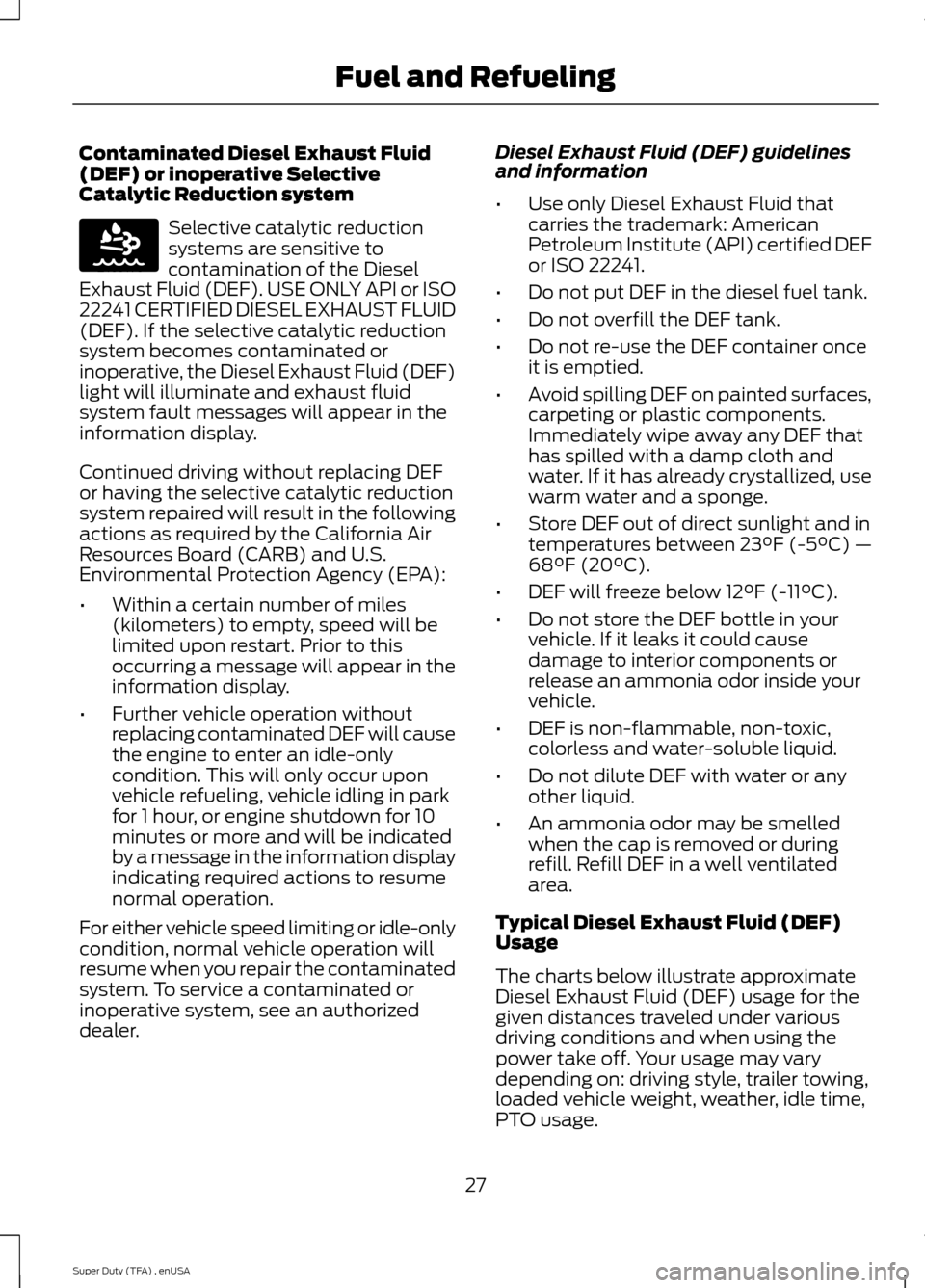
Contaminated Diesel Exhaust Fluid
(DEF) or inoperative Selective
Catalytic Reduction system
Selective catalytic reduction
systems are sensitive to
contamination of the Diesel
Exhaust Fluid (DEF). USE ONLY API or ISO
22241 CERTIFIED DIESEL EXHAUST FLUID
(DEF). If the selective catalytic reduction
system becomes contaminated or
inoperative, the Diesel Exhaust Fluid (DEF)
light will illuminate and exhaust fluid
system fault messages will appear in the
information display.
Continued driving without replacing DEF
or having the selective catalytic reduction
system repaired will result in the following
actions as required by the California Air
Resources Board (CARB) and U.S.
Environmental Protection Agency (EPA):
• Within a certain number of miles
(kilometers) to empty, speed will be
limited upon restart. Prior to this
occurring a message will appear in the
information display.
• Further vehicle operation without
replacing contaminated DEF will cause
the engine to enter an idle-only
condition. This will only occur upon
vehicle refueling, vehicle idling in park
for 1 hour, or engine shutdown for 10
minutes or more and will be indicated
by a message in the information display
indicating required actions to resume
normal operation.
For either vehicle speed limiting or idle-only
condition, normal vehicle operation will
resume when you repair the contaminated
system. To service a contaminated or
inoperative system, see an authorized
dealer. Diesel Exhaust Fluid (DEF) guidelines
and information
•
Use only Diesel Exhaust Fluid that
carries the trademark: American
Petroleum Institute (API) certified DEF
or ISO 22241.
• Do not put DEF in the diesel fuel tank.
• Do not overfill the DEF tank.
• Do not re-use the DEF container once
it is emptied.
• Avoid spilling DEF on painted surfaces,
carpeting or plastic components.
Immediately wipe away any DEF that
has spilled with a damp cloth and
water. If it has already crystallized, use
warm water and a sponge.
• Store DEF out of direct sunlight and in
temperatures between 23°F (-5°C) —
68°F (20°C).
• DEF will freeze below 12°F (-11°C).
• Do not store the DEF bottle in your
vehicle. If it leaks it could cause
damage to interior components or
release an ammonia odor inside your
vehicle.
• DEF is non-flammable, non-toxic,
colorless and water-soluble liquid.
• Do not dilute DEF with water or any
other liquid.
• An ammonia odor may be smelled
when the cap is removed or during
refill. Refill DEF in a well ventilated
area.
Typical Diesel Exhaust Fluid (DEF)
Usage
The charts below illustrate approximate
Diesel Exhaust Fluid (DEF) usage for the
given distances traveled under various
driving conditions and when using the
power take off. Your usage may vary
depending on: driving style, trailer towing,
loaded vehicle weight, weather, idle time,
PTO usage.
27
Super Duty (TFA) , enUSA Fuel and RefuelingE163176
Page 35 of 84
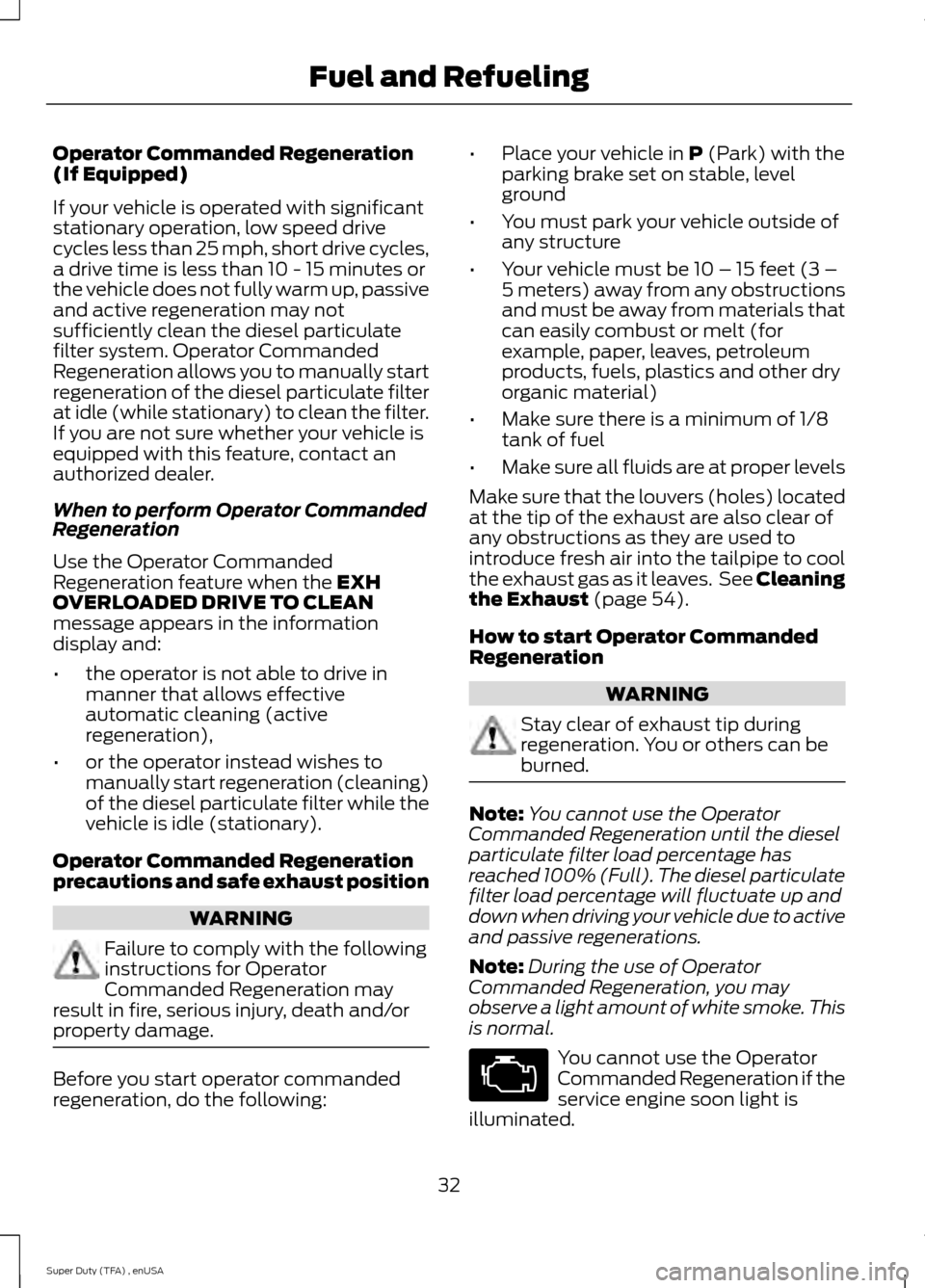
Operator Commanded Regeneration
(If Equipped)
If your vehicle is operated with significant
stationary operation, low speed drive
cycles less than 25 mph, short drive cycles,
a drive time is less than 10 - 15 minutes or
the vehicle does not fully warm up, passive
and active regeneration may not
sufficiently clean the diesel particulate
filter system. Operator Commanded
Regeneration allows you to manually start
regeneration of the diesel particulate filter
at idle (while stationary) to clean the filter.
If you are not sure whether your vehicle is
equipped with this feature, contact an
authorized dealer.
When to perform Operator Commanded
Regeneration
Use the Operator Commanded
Regeneration feature when the EXH
OVERLOADED DRIVE TO CLEAN
message appears in the information
display and:
• the operator is not able to drive in
manner that allows effective
automatic cleaning (active
regeneration),
• or the operator instead wishes to
manually start regeneration (cleaning)
of the diesel particulate filter while the
vehicle is idle (stationary).
Operator Commanded Regeneration
precautions and safe exhaust position WARNING
Failure to comply with the following
instructions for Operator
Commanded Regeneration may
result in fire, serious injury, death and/or
property damage. Before you start operator commanded
regeneration, do the following: •
Place your vehicle in
P (Park) with the
parking brake set on stable, level
ground
• You must park your vehicle outside of
any structure
• Your vehicle must be 10 – 15 feet (3 –
5 meters) away from any obstructions
and must be away from materials that
can easily combust or melt (for
example, paper, leaves, petroleum
products, fuels, plastics and other dry
organic material)
• Make sure there is a minimum of 1/8
tank of fuel
• Make sure all fluids are at proper levels
Make sure that the louvers (holes) located
at the tip of the exhaust are also clear of
any obstructions as they are used to
introduce fresh air into the tailpipe to cool
the exhaust gas as it leaves. See Cleaning
the Exhaust
(page 54).
How to start Operator Commanded
Regeneration WARNING
Stay clear of exhaust tip during
regeneration. You or others can be
burned.
Note:
You cannot use the Operator
Commanded Regeneration until the diesel
particulate filter load percentage has
reached 100% (Full). The diesel particulate
filter load percentage will fluctuate up and
down when driving your vehicle due to active
and passive regenerations.
Note: During the use of Operator
Commanded Regeneration, you may
observe a light amount of white smoke. This
is normal. You cannot use the Operator
Commanded Regeneration if the
service engine soon light is
illuminated.
32
Super Duty (TFA) , enUSA Fuel and Refueling
Page 36 of 84

Information display procedure
Start with your vehicle engine fully warmed
and then press the Info button on the
steering wheel until the information display
reads one of the following choices:
• EXHST XX% FULL CLEAN? Y/N
• EXHAUST FULL CLEAN? Y/N
Answer yes to this prompt and then follow
the prompts regarding exhaust position as
needed to initiate Operator Commanded
Regeneration. Be sure to understand each
prompt. If you are not sure what is being
asked by each prompt, contact an
authorized dealer. The display will confirm
the operation has started and when it has
finished.
If the diesel particulate filter is near or at
saturation, a message requesting
permission to initiate filter cleaning will
display
EXH AT LIMIT CLEAN? Y/N.
Answer yes to this prompt and then follow
the prompts regarding exhaust position as
needed to initiate Operator Commanded
Regeneration. Be sure to understand each
prompt. If you are not sure what is being
asked by each prompt, contact an
authorized dealer. The display will confirm
the operation has started and when it has
finished. You can also drive to clean the
filter. See Active regeneration earlier in this
chapter. When the system is at the point
of oversaturation, the service
engine soon light will illuminate
and the following message
EXH OVER
LIMIT SERVICE NOW will appear . You
will not be able to allow cleaning. You
must have your vehicle serviced by an
authorized dealer. Once operator commanded regeneration
starts, the engine
’s rpm will rise to
approximately 2,000 - 2,400 rpm and the
cooling fan will increase speed; you will
hear a change in audible sound due to the
fan and engine speed increase.
It is not necessary to open the hood on the
engine compartment. Once Operator
Commanded Regeneration is complete,
the engine rpm and fan will return to
normal idling. The exhaust system will
remain very hot for several minutes even
after regeneration is complete. Do not
reposition the vehicle over materials that
could burn until the exhaust system has
had sufficient time to cool. Depending on
the amount of soot collected by the diesel
particulate filter, ambient temperature,
and altitude, Operator Commanded
Regeneration may last from 10 to 25
minutes.
How to interrupt or cancel Operator
Commanded Regeneration
If you need to cancel the Operator
Commanded Regeneration, pressing the
brake, accelerator, or shutting off the
vehicle will stop the procedure. Depending
on the amount of time you allowed the
Operator Commanded Regeneration to
operate, soot may not have had sufficient
time to be eliminated, but the exhaust
system and exhaust gas may still be hot.
If you shut your vehicle off during Operator
Commanded Regeneration, you will notice
turbo flutter. This is a normal consequence
caused by shutting off a diesel engine
during boosted operation and is considered
normal.
Filter service and maintenance
Over time, a slight amount of ash will build
up in the diesel particulate filter, which is
not removed during the regeneration
process. The filter may need to be removed
for ash cleaning at approximately 120,000
miles (193,000 km) or greater (actual
33
Super Duty (TFA) , enUSA Fuel and Refueling
Page 37 of 84
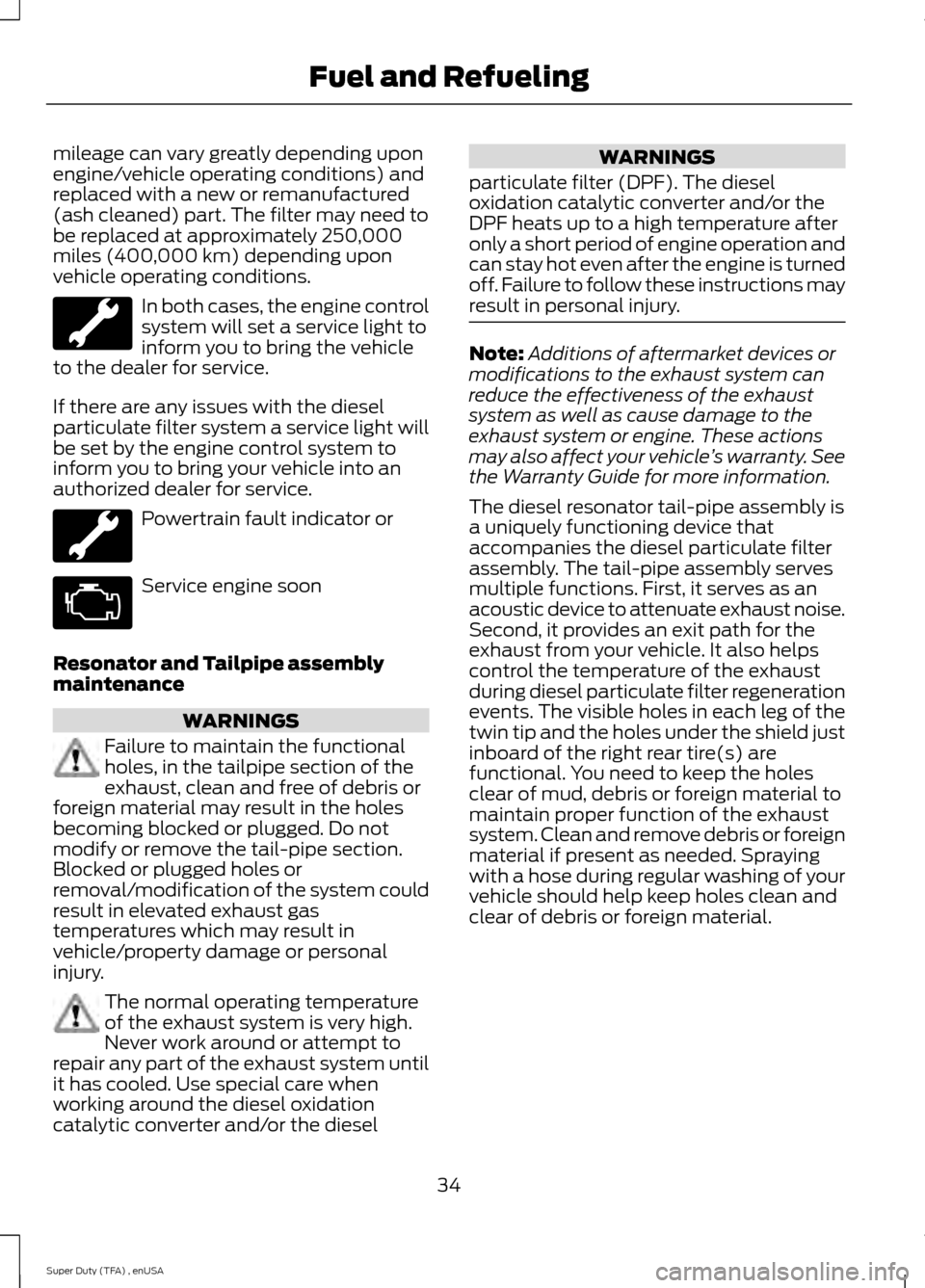
mileage can vary greatly depending upon
engine/vehicle operating conditions) and
replaced with a new or remanufactured
(ash cleaned) part. The filter may need to
be replaced at approximately 250,000
miles (400,000 km) depending upon
vehicle operating conditions.
In both cases, the engine control
system will set a service light to
inform you to bring the vehicle
to the dealer for service.
If there are any issues with the diesel
particulate filter system a service light will
be set by the engine control system to
inform you to bring your vehicle into an
authorized dealer for service. Powertrain fault indicator or
Service engine soon
Resonator and Tailpipe assembly
maintenance WARNINGS
Failure to maintain the functional
holes, in the tailpipe section of the
exhaust, clean and free of debris or
foreign material may result in the holes
becoming blocked or plugged. Do not
modify or remove the tail-pipe section.
Blocked or plugged holes or
removal/modification of the system could
result in elevated exhaust gas
temperatures which may result in
vehicle/property damage or personal
injury. The normal operating temperature
of the exhaust system is very high.
Never work around or attempt to
repair any part of the exhaust system until
it has cooled. Use special care when
working around the diesel oxidation
catalytic converter and/or the diesel WARNINGS
particulate filter (DPF). The diesel
oxidation catalytic converter and/or the
DPF heats up to a high temperature after
only a short period of engine operation and
can stay hot even after the engine is turned
off. Failure to follow these instructions may
result in personal injury. Note:
Additions of aftermarket devices or
modifications to the exhaust system can
reduce the effectiveness of the exhaust
system as well as cause damage to the
exhaust system or engine. These actions
may also affect your vehicle ’s warranty. See
the Warranty Guide for more information.
The diesel resonator tail-pipe assembly is
a uniquely functioning device that
accompanies the diesel particulate filter
assembly. The tail-pipe assembly serves
multiple functions. First, it serves as an
acoustic device to attenuate exhaust noise.
Second, it provides an exit path for the
exhaust from your vehicle. It also helps
control the temperature of the exhaust
during diesel particulate filter regeneration
events. The visible holes in each leg of the
twin tip and the holes under the shield just
inboard of the right rear tire(s) are
functional. You need to keep the holes
clear of mud, debris or foreign material to
maintain proper function of the exhaust
system. Clean and remove debris or foreign
material if present as needed. Spraying
with a hose during regular washing of your
vehicle should help keep holes clean and
clear of debris or foreign material.
34
Super Duty (TFA) , enUSA Fuel and Refueling
Page 38 of 84
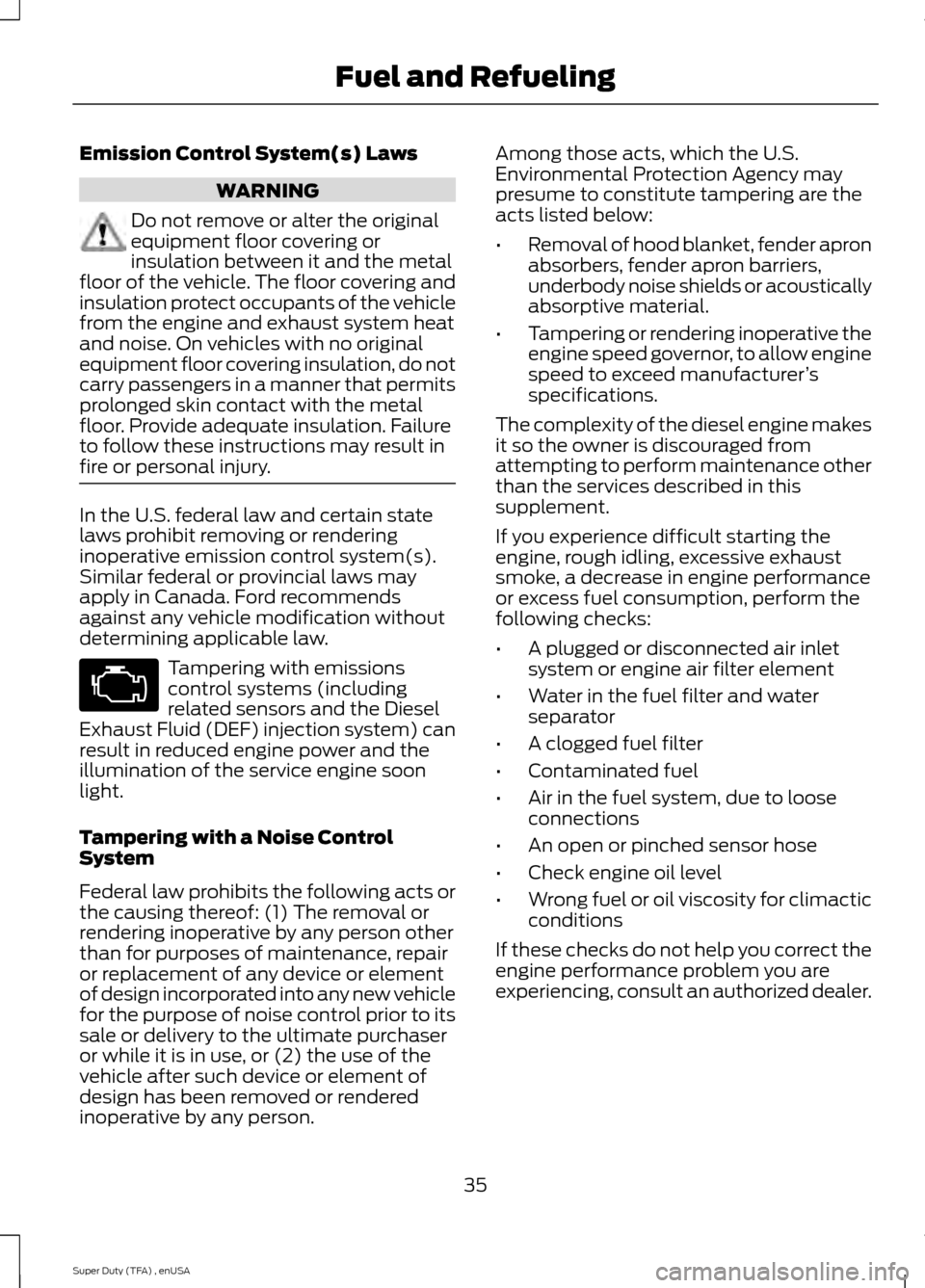
Emission Control System(s) Laws
WARNING
Do not remove or alter the original
equipment floor covering or
insulation between it and the metal
floor of the vehicle. The floor covering and
insulation protect occupants of the vehicle
from the engine and exhaust system heat
and noise. On vehicles with no original
equipment floor covering insulation, do not
carry passengers in a manner that permits
prolonged skin contact with the metal
floor. Provide adequate insulation. Failure
to follow these instructions may result in
fire or personal injury. In the U.S. federal law and certain state
laws prohibit removing or rendering
inoperative emission control system(s).
Similar federal or provincial laws may
apply in Canada. Ford recommends
against any vehicle modification without
determining applicable law.
Tampering with emissions
control systems (including
related sensors and the Diesel
Exhaust Fluid (DEF) injection system) can
result in reduced engine power and the
illumination of the service engine soon
light.
Tampering with a Noise Control
System
Federal law prohibits the following acts or
the causing thereof: (1) The removal or
rendering inoperative by any person other
than for purposes of maintenance, repair
or replacement of any device or element
of design incorporated into any new vehicle
for the purpose of noise control prior to its
sale or delivery to the ultimate purchaser
or while it is in use, or (2) the use of the
vehicle after such device or element of
design has been removed or rendered
inoperative by any person. Among those acts, which the U.S.
Environmental Protection Agency may
presume to constitute tampering are the
acts listed below:
•
Removal of hood blanket, fender apron
absorbers, fender apron barriers,
underbody noise shields or acoustically
absorptive material.
• Tampering or rendering inoperative the
engine speed governor, to allow engine
speed to exceed manufacturer ’s
specifications.
The complexity of the diesel engine makes
it so the owner is discouraged from
attempting to perform maintenance other
than the services described in this
supplement.
If you experience difficult starting the
engine, rough idling, excessive exhaust
smoke, a decrease in engine performance
or excess fuel consumption, perform the
following checks:
• A plugged or disconnected air inlet
system or engine air filter element
• Water in the fuel filter and water
separator
• A clogged fuel filter
• Contaminated fuel
• Air in the fuel system, due to loose
connections
• An open or pinched sensor hose
• Check engine oil level
• Wrong fuel or oil viscosity for climactic
conditions
If these checks do not help you correct the
engine performance problem you are
experiencing, consult an authorized dealer.
35
Super Duty (TFA) , enUSA Fuel and Refueling
Page 40 of 84
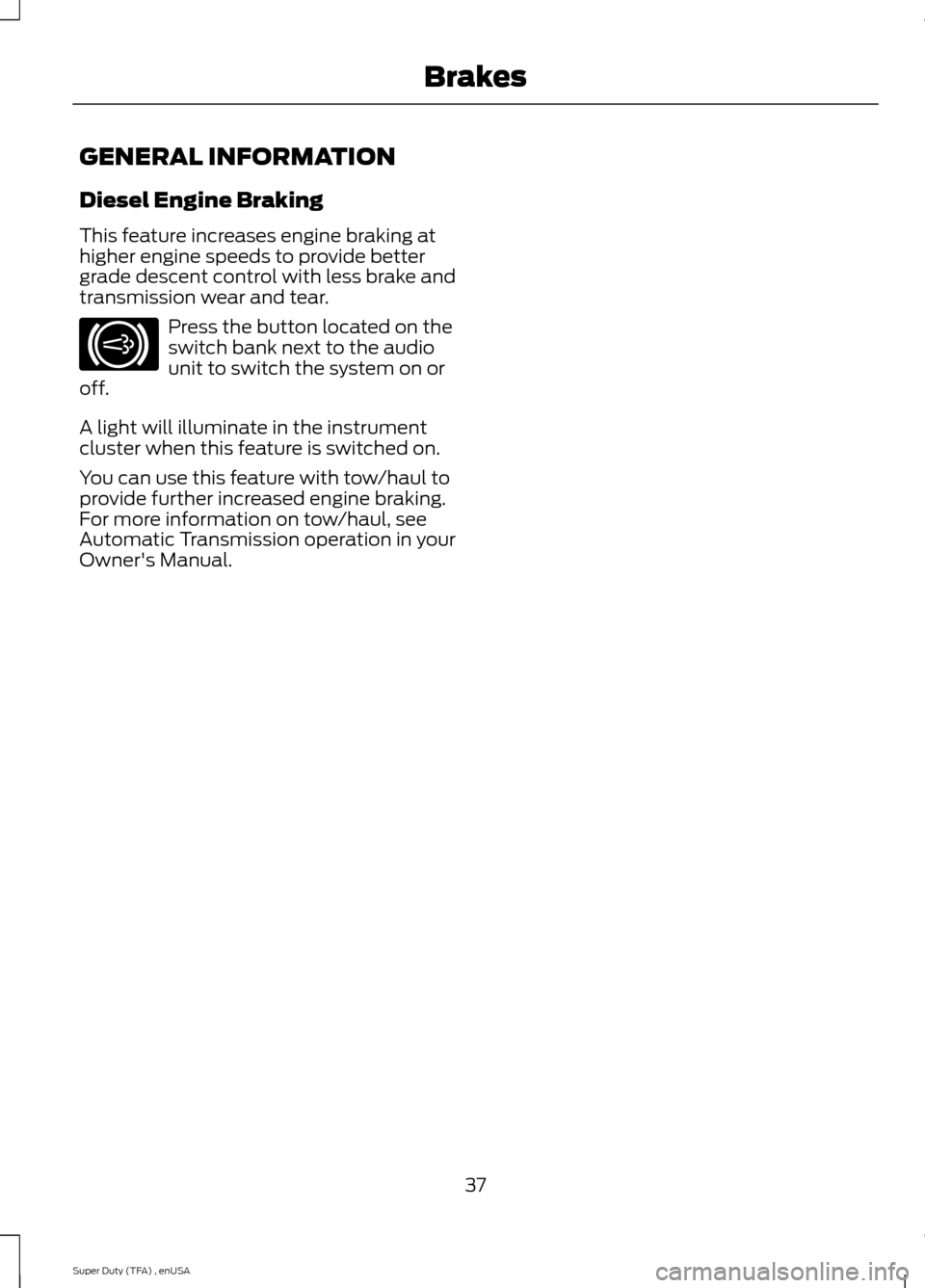
GENERAL INFORMATION
Diesel Engine Braking
This feature increases engine braking at
higher engine speeds to provide better
grade descent control with less brake and
transmission wear and tear.
Press the button located on the
switch bank next to the audio
unit to switch the system on or
off.
A light will illuminate in the instrument
cluster when this feature is switched on.
You can use this feature with tow/haul to
provide further increased engine braking.
For more information on tow/haul, see
Automatic Transmission operation in your
Owner's Manual.
37
Super Duty (TFA) , enUSA BrakesE171217
Page 49 of 84
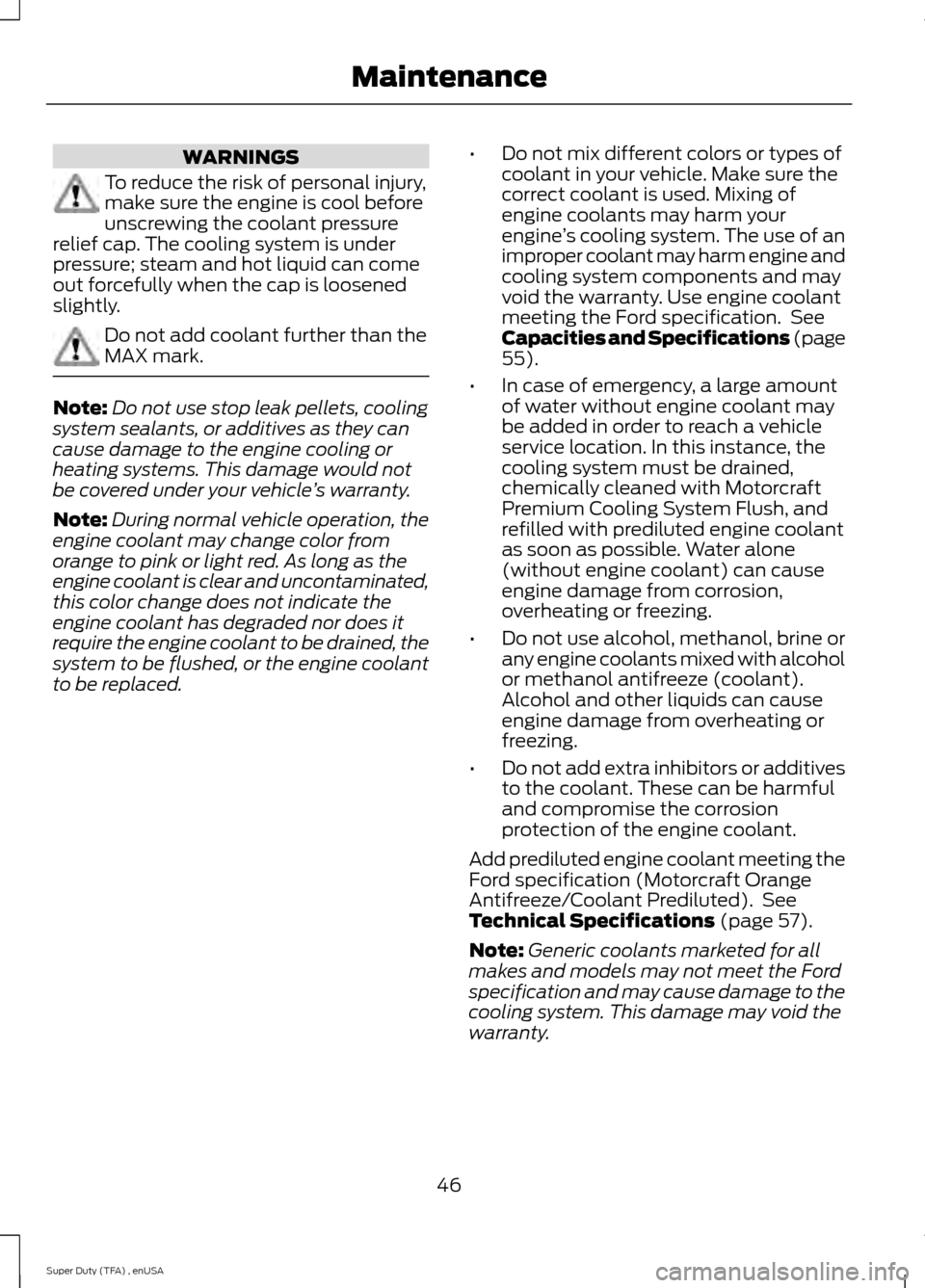
WARNINGS
To reduce the risk of personal injury,
make sure the engine is cool before
unscrewing the coolant pressure
relief cap. The cooling system is under
pressure; steam and hot liquid can come
out forcefully when the cap is loosened
slightly. Do not add coolant further than the
MAX mark.
Note:
Do not use stop leak pellets, cooling
system sealants, or additives as they can
cause damage to the engine cooling or
heating systems. This damage would not
be covered under your vehicle ’s warranty.
Note: During normal vehicle operation, the
engine coolant may change color from
orange to pink or light red. As long as the
engine coolant is clear and uncontaminated,
this color change does not indicate the
engine coolant has degraded nor does it
require the engine coolant to be drained, the
system to be flushed, or the engine coolant
to be replaced. •
Do not mix different colors or types of
coolant in your vehicle. Make sure the
correct coolant is used. Mixing of
engine coolants may harm your
engine ’s cooling system. The use of an
improper coolant may harm engine and
cooling system components and may
void the warranty. Use engine coolant
meeting the Ford specification. See
Capacities and Specifications (page
55).
• In case of emergency, a large amount
of water without engine coolant may
be added in order to reach a vehicle
service location. In this instance, the
cooling system must be drained,
chemically cleaned with Motorcraft
Premium Cooling System Flush, and
refilled with prediluted engine coolant
as soon as possible. Water alone
(without engine coolant) can cause
engine damage from corrosion,
overheating or freezing.
• Do not use alcohol, methanol, brine or
any engine coolants mixed with alcohol
or methanol antifreeze (coolant).
Alcohol and other liquids can cause
engine damage from overheating or
freezing.
• Do not add extra inhibitors or additives
to the coolant. These can be harmful
and compromise the corrosion
protection of the engine coolant.
Add prediluted engine coolant meeting the
Ford specification (Motorcraft Orange
Antifreeze/Coolant Prediluted). See
Technical Specifications
(page 57).
Note: Generic coolants marketed for all
makes and models may not meet the Ford
specification and may cause damage to the
cooling system. This damage may void the
warranty.
46
Super Duty (TFA) , enUSA Maintenance